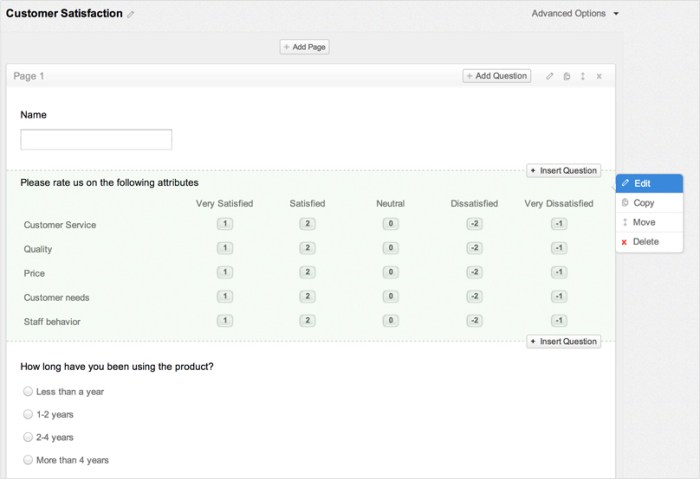Creating Online Surveys dives into the world of digital feedback collection with a fresh and dynamic approach that resonates with today’s tech-savvy audience. From planning to analysis, this guide has you covered every step of the way.
Overview of Online Surveys
Online surveys are digital questionnaires that are used to gather information from a target audience. They are commonly utilized by businesses, organizations, and researchers to collect valuable data for analysis and decision-making.
Purpose of Online Surveys
Online surveys serve the purpose of collecting feedback, opinions, and preferences from a wide range of participants in a convenient and cost-effective manner. They help in understanding customer satisfaction, market trends, employee engagement, and much more.
Benefits of Online Surveys
- Convenience: Participants can fill out surveys at their own pace and from any location with an internet connection.
- Cost-effectiveness: Online surveys eliminate the need for printing and postage, saving money on distribution.
- Quick data collection: Responses are automatically recorded and can be analyzed in real-time, speeding up the decision-making process.
Types of Questions in Online Surveys
- Multiple Choice: Participants choose from a list of predefined options.
- Open-Ended: Participants provide a free-form response in their own words.
- Rating Scales: Participants rate items on a scale, such as from 1 to 5.
Examples of Industries Using Online Surveys
- Market Research: Companies use online surveys to gather consumer feedback and insights on products and services.
- Education: Schools and universities use online surveys to collect feedback from students and parents on various programs and services.
- Healthcare: Hospitals and clinics use online surveys to assess patient satisfaction and improve the quality of care.
Planning an Online Survey

When planning an online survey, it is crucial to consider the target audience, define clear objectives, create concise survey questions, and maximize response rates.
Target Audience
Identifying the target audience is essential to ensure that the survey will provide relevant and valuable insights. Consider demographics such as age, gender, location, and interests to tailor the survey questions accordingly.
Defining Objectives
Clearly defining the objectives of the survey is crucial for determining the purpose and desired outcomes. Whether it is to gather feedback, measure customer satisfaction, or conduct market research, make sure the objectives are specific, measurable, achievable, relevant, and time-bound (SMART).
Creating Clear Questions
To create clear and concise survey questions, avoid using jargon or complex language. Keep the questions simple, direct, and relevant to the objectives of the survey. Use multiple-choice, rating scales, or open-ended questions strategically to gather valuable insights from respondents.
Maximizing Response Rates
To maximize response rates, consider the timing of the survey, personalize the invitation to participate, keep the survey short and focused, offer incentives for completing the survey, and follow up with reminders to non-respondents. Additionally, ensure that the survey is mobile-friendly for easy access on various devices.
Designing the Survey: Creating Online Surveys
When it comes to designing an online survey, there are several key factors to consider to ensure that your survey is effective and yields valuable insights. From choosing the right online survey tool to creating a visually appealing layout, each step plays a crucial role in the success of your survey.
Choosing an Online Survey Tool
- Consider the features: Look for a tool that offers a wide range of question types, customization options, and analytics capabilities.
- Check the pricing: Compare different tools to find one that fits your budget and offers the features you need.
- Ensure user-friendliness: Opt for a tool that is easy to use for both survey creators and respondents.
Importance of Survey Layout and Design, Creating Online Surveys
- Clear and concise: Keep the layout simple and easy to navigate for respondents to avoid confusion.
- Branding: Incorporate your brand elements like colors and logos to make the survey more visually appealing and recognizable.
- Mobile compatibility: Ensure that the survey design is responsive and works well on different devices to reach a wider audience.
Creating a Visually Appealing Survey
- Use visuals: Incorporate images or videos to make the survey more engaging and interactive.
- Consistent design: Maintain a consistent color scheme and font style throughout the survey for a professional look.
- Whitespace: Use ample whitespace to avoid clutter and make the survey easier to read and respond to.
Best Practices for Organizing Survey Questions Logically
- Start with demographics: Begin the survey with basic demographic questions before moving on to more specific topics.
- Group similar questions: Organize questions into logical groups to make it easier for respondents to follow and provide accurate responses.
- Avoid leading questions: Ensure that questions are neutral and unbiased to gather honest feedback from respondents.
Distributing and Collecting Responses

To ensure the success of your online survey, it is crucial to effectively distribute it and collect responses from a wide audience. Utilizing various methods and strategies can help increase engagement and participation, ultimately providing you with valuable data and insights.
Options for Distributing the Survey
- Utilize email campaigns to reach out to a targeted list of contacts. Personalize the emails to increase response rates.
- Share the survey on social media platforms such as Facebook, Twitter, and LinkedIn to reach a broader audience. Encourage followers to share the survey with their networks.
- Embed the survey link on your website or blog to capture responses from visitors who are already engaged with your content.
Reaching a Wider Audience
- Collaborate with influencers or industry experts to promote the survey to their followers, increasing visibility and participation.
- Consider running targeted ads on social media platforms to reach specific demographics or interest groups.
- Partner with other organizations or websites to co-promote the survey and tap into their existing audience base.
Tracking and Monitoring Responses in Real-Time
- Utilize online survey tools that provide real-time analytics and reporting to track responses as they come in.
- Set up automated notifications for new responses to stay informed and address any issues or trends promptly.
- Regularly check the survey data to identify any drop-off points or areas for improvement in the survey design or distribution strategy.
Increasing Engagement and Participation
- Offer incentives such as discounts, giveaways, or exclusive content to encourage participation and completion of the survey.
- Create engaging survey questions with clear instructions and a user-friendly interface to keep respondents interested and motivated.
- Follow up with reminders to those who have not yet completed the survey, gently nudging them to participate before the deadline.
Analyzing Survey Results
Analyzing survey results is crucial to extracting valuable insights and making informed decisions based on the data collected. By effectively analyzing survey data, you can identify trends, patterns, and key takeaways that can help drive business strategies or initiatives.
Tools for Analyzing Survey Results
There are various tools and software available to help analyze survey results. Some popular options include:
- SurveyMonkey: A user-friendly platform that offers basic analytics and reporting features.
- Qualtrics: Provides advanced analytics capabilities for in-depth data analysis.
- Google Forms: Offers basic reporting tools and integrates seamlessly with Google Sheets for further analysis.
Key Metrics in Survey Analysis
When analyzing survey results, it’s essential to look out for key metrics that can provide valuable insights. Some key metrics to consider include:
- Response Rate: Percentage of survey responses received compared to the total number of surveys distributed.
- Net Promoter Score (NPS): Measures customer loyalty and satisfaction based on the likelihood of recommending a product or service.
- Average Rating: Average score given by respondents for specific survey questions or overall satisfaction levels.
Tips for Interpreting Survey Responses
Interpreting survey responses requires careful consideration and analysis to draw meaningful insights. Some tips for interpreting survey responses include:
- Look for trends: Identify patterns or trends in the data that can reveal common themes or issues.
- Compare data: Compare survey results across different segments or time periods to identify changes or correlations.
- Consider open-ended responses: Pay attention to qualitative feedback to gain deeper insights into respondents’ thoughts and feelings.